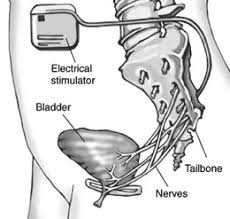 Sacral nerve stimulation, also termed sacral neuromodulation, is a type of medical electrical stimulation therapy.
Sacral nerve stimulation, also termed sacral neuromodulation, is a type of medical electrical stimulation therapy.
Sacral nerve stimulation involves the implantation of a programmable stimulator subcutaneously, which delivers low amplitude electrical stimulation via a lead to the sacral nerve, usually accessed via the S3 foramen.
InterStim Therapy, by Medtronic, as a sacral nerve stimulator for treatment of urinary incontinence, high urinary frequency and urinary retention.
Sacral nerve stimulation is also under investigation as treatment for other conditions, including constipation.
Where the nerves and the brain are no longer communicating effectively, resulting in a bowel/bladder disorder, this type of treatment is designed to imitate a signal sent via the central nervous system.
One of the major nerve routes from the brain, along the spinal cord and through the back is the sacral area.
The sacral area controls the everyday function of the pelvic floor, urethral sphincter, bladder and bowel.
Sacral nerve stimulation manipulates a contraction within the pelvic floor, and over time these contractions rebuild the strength of the organs and muscles within it.
It effectively alleviates all symptoms of urinary/faecal disorders, and in many cases eliminates them completely.
The patient is selected, he receives a temporary external pulse generator connected to wire leads at S3 foramina for 1–2 weeks.
If the person’s symptoms improve by more than 50%, a permanent wire leads and stimulator that is implanted in the hip in the subcutaneous tissue.
Complications:Bleeding, infection, pain and unwanted stimulation in the extremities.
Currently, battery replacements are necessary 5–10 years after implementation depending upon the strength of the stimulation therapy.
This procedure has shown long term success rate that ranges from 50% to 90%, for lower urinary tract dysfunction refractive to conservative and pharmacological interventions.
Fecal incontinence, the involuntary loss of stool and flatus release afflicting mainly elderly people, can also be treated with sacral nerve stimulation as long as patients have intact sphincter muscles.
However, limited evidence from a Cochrane review of randomised controlled trials suggests that sacral nerve stimulation may help to reduce fecal incontinence.
